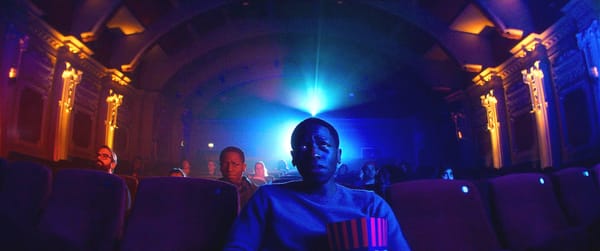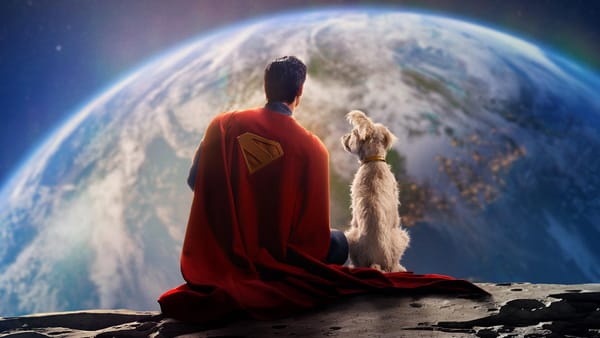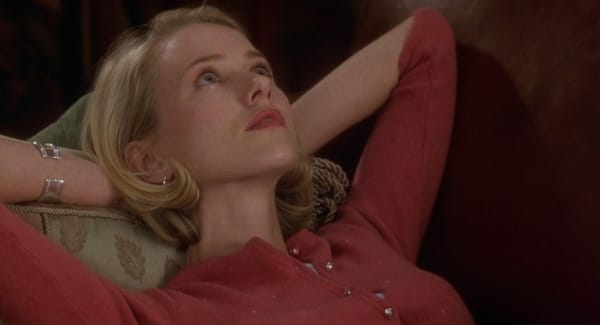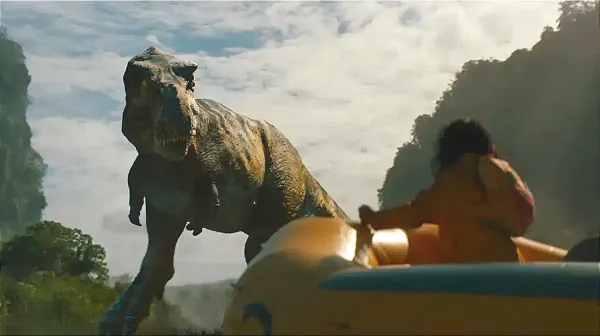Fathers and Sons
The Netflix documentary "Sr." lets two generations of Robert Downeys share a final scene together. Plus: The best Robert Downey Jr. movie that isn't actually a movie.

“Sr.” (⭐ ⭐ ⭐ 1/2, now streaming on Netflix) is a gift, from Robert Downey Jr. to his father, from Robert Downey Sr. to his son, and from the two of them to us. The documentary covers the last year or so of the older Downey’s life before his death in July 2021 from complications of Parkinson’s Disease; it’s directed by Chris Smith (“American Movie,” “The Tiger King”), who exists mostly as a discreet offscreen voice. But, really, “Sr.” is a dialogue between its movie-star producer and its cult-director subject, who are onscreen hashing out a father-son dynamic no less complicated for its years of mellowing. The scars are still tender. The tenderness is overwhelming. If you’ve ever bid farewell to an aging parent, the movie stands to conjure up a helter-skelter of emotions, many of them warmly moving, others that come with a bitter aftertaste. If you never had a chance to bid farewell, “Sr.” prompts equally profound thoughts of What If.
Who’s Robert Downey Sr., anyway? For one thing, he’s Sr. only because Jr. is a global superstar. If you grew up in the 1960s and 70s, he was simply Robert Downey, director of cockeyed avant-garde comedies, some of which were counterculture hits. (Paul Thomas Anderson, among others, is a huge fan.) “Putney Swope” (1969) was the breakthrough, a bizarrely hilarious satire about an ad agency led by militant Black executives after the white chairman has a heart attack. Defiantly scrappy and intentionally unslick, the movie was a stink-bomb lobbed into the middle of the prevailing pop culture; critics loved it, midnight audiences ate it up, and in 2019, “Putney Swope” was elected for preservation by the American Film Institute. “Putney says the Borman 6 girl is got to have soul!” And she does.
I didn’t see that one in the theater – at 12, I don’t think I would have been allowed in – but I remember going to see “Greaser‘s Palace” (1972) at 15 and having my adolescent doors blown off by Downey’s airlifting of the Holy Trinity into the American West, with Jesus (Alan Arbus) a zoot suit-wearing hipster who tap-dances on water and the Holy Ghost a guy in a bedsheet. And who’s the little boy who dies and is resurrected? Why, it’s 7-year-old Robert Downey Jr.
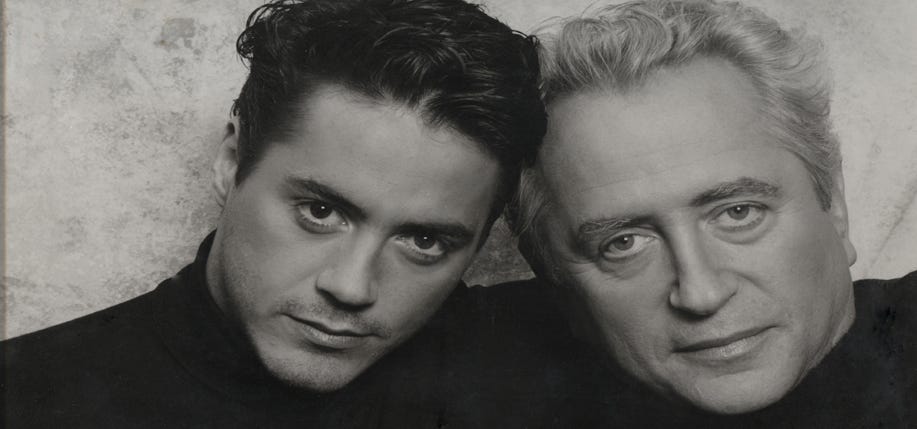
Before those films, Downey père was an antic New York-based free spirit whose movies landed somewhere between Warhol (but funnier) and early John Waters (but more innocent); the work from this period, including “Putney Swope,” is currently featured on the Criterion Channel in a six-film package titled “Up All Night with Robert Downey Sr.” After “Greaser’s Palace,” he went to Los Angeles, where he fit in like a hexagonal peg in a round hole – whoever hired this man to direct the nominally mainstream comedy “Up the Academy” must have been out of his mind — and several decades ended up getting lost to Mr. Cocaine and his friends. Downey looks to have been one of those dads who’s a nonstop party when you’re a kid and a perpetual hangover when you’re older, and whether he imparted addiction to his son or his son found it on his own is beside the point. That there’s a lot of muddy water under this bridge is evident when Downey Jr. ruefully says of Dad’s bad old days, “I think it would be remiss to not discuss its effect on me,” and Downey Sr. sighs in response, “Yeah, boy, I could sure love to miss that discussion.”
But “Sr.” is about things being said rather than left unsaid, and the generosity shown by the son toward the father in the latter’s remaining months just about breaks your heart. He lets Downey Sr. take some of the footage and fashion his own alternate cut, a prankster still sticking it to the man. When Sr. asks Jr. to sing the Schubert lieder “Fischerweise” just like he did in a grammar school show, the 54-year-old Robert Downey Jr. affectionately obliges (with Sean Hayes providing pianoforte accompaniment). Even the decision to shoot the documentary in black and white feels like a doff of the fedora to the old man. Underneath it all is the suppressed panic that comes with time running out and the love of two people speaking to each other through the only medium they understand. It’s a lovely movie.
Among other reasons, I’m drawn to “Sr.” because Robert Downey Jr. has always seemed to me to be particularly adroit and self-aware about his career and his fame, even during the dark days of the late 1990s and early 2000s, when he looked like the next celebrity casualty waiting to happen. Downey’s talent – quick-witted, ironic, oddly sensible – became his persona, and that persona has in recent decades been hidden under the bushel of the Marvel Cinematic Universe and other intellectual property juggernauts. (I don’t know if you’ve seen his Sherlock Holmes movies, but they’re awful, and the less said about 2020’s “Dolittle,” the better.) I don’t know when we’ll have the loose, unpredictable, and slightly dangerous Downey of “Kiss Kiss Bang Bang” or “Zodiac” back again. One can hope.
There’s a clip of the actor I show in my college journalism classes, but it’s not from one of Downey’s movies. It’s a video from the publicity tour for “Avengers: The Age of Ultron,” a junket interview that went south and then went viral after the interviewer, British journalist Krishnan Guru-Murthy, tried to sucker punch the star with questions about his politics and his past and Downey responded by walking out. I make the students watch the clip in its 7-minute entirety (and I urge you to do the same) for a number of different reasons. First: Which man’s in the right here? One? Neither? Both? And why do you feel that way? Shouldn’t a celebrity sitting for an interview expect to be asked anything? Shouldn’t a reporter hoping to have a productive (not to mention ethical) conversation avoid gotcha questions? The classroom discussions that ensue – and, remember, these are kids who want to have careers in journalism – are never not fascinating. (If you want to watch the video and weigh in, please do so — comments are open to everyone today.)
The other reason I show the clip is that it’s just ridiculously entertaining – suspenseful, even. Nothing much happens for the first four minutes: Downey chats obligingly and articulately about the nature of his Iron Man/Tony Stark character, and any reasonably sentient observer can tell that he’s serving up a fine plate of bullshit. But it’s not condescending bullshit – not lazy or smug. You’re watching an actor in a performance of his contractual duty of promoting a film in his best professional manner and in the face of some fairly fatuous questions. Which, honestly, is all any entertainment reporter can hope for. Back in my Entertainment Weekly days, I loved the two times I got to call Julia Roberts for back-up interviews. Her publicist would promise me 15 minutes, Roberts made herself available spot on time, pleasantly and thoughtfully answered every question, and when the 15 minutes was up – to the second – she would say, “OK, thanks, goodbye,” and be gone. Like I said, professional.
So: Downey is rolling along nicely, hitting his marks, until Guru-Murthy throws a curveball, asking about a statement the actor made years earlier, after he had come out of prison, that seemed to betray right-wing tendencies. It’s something to see: Downey’s gears jam, he stutters a bit, the mask of PR performance slips. But he recovers nicely and gives a practiced non-answer answer, something on the order of “Who the hell knows if I still mean something I said a decade ago?” Guru-Murthy presses nervously ahead, trying to get the actor to talk about his dark days. Downey’s eyes narrow, and he glances at an offscreen PR person in confusion: “Are we promoting a movie?” And, indeed, that’s what he’s there for and all that he is there for, and to mistake this for an actual interview is a severe misunderstanding of the rules. The vibe turns tense and the actor turns mocking, seeking and finding the upper hand in the power dynamic. But the journalist keeps going, and there’s this marvelous moment, right after he has had the idiot temerity to mention Robert Downey Sr., where the mask slips completely off and Downey Jr. uncorks a stare of magisterial hatred – pure contempt. A stare that should by rights reduce the hapless journalist to a smudge of soot on a studio stool. This is the moment where my students let out a collective moan of horror-movie delight, every time: They see the killer coming for his victim and they’re powerless to stop him.
The Stare has caused Guru-Murthy to become thoroughly unglued, but Downey is still furious. You can see it in his eyes: What does this yutz know about anything I’ve gone through? Why won’t he stick to the script? How dare he bring up my father? Downey’s not Tony Stark, he’s pissed-off Tony Stark. And at a certain point, he says enough, unhooks his microphone and is out of there.
Is he being a spoiled movie star? Or is he a man protecting his private life from a media maw that just wants to chew on the sensational bits? (It’s worth noting that this video probably got Guru-Murthy seen by millions more people than watch Britain’s Channel 4.) I tend toward the latter view, but I welcome the discussion, because anything that lets us pierce the bubble of celebrity engagement and understand that these are actual people – actors, not superheroes or gods – makes our culture a healthier field of play.
I think Robert Downey Jr. understands this. In fact, I know he understands it, because earlier in the interview, he lets slip a comment – an aside, really – that cuts the legs out from anybody who claims to know a famous person whom they haven’t actually met. The way someone might say – did say, in one of my classes this past spring, “Oh, I know Johnny Depp, and he’d never do that.” Well, no, you don’t know Johnny Depp. You know his persona, and that ain’t the same thing at all. As the great sage Robert Downey Jr. tells Krishnan Guru-Murthy, in words that fly over the journalist’s head and the heads of everyone in the room, “None of us are our personas.”
Sometimes I play this for the students a couple of times, in the hopes it’ll sink in. How’s that, Robert?
Exactly.
Thoughts? Comments? Don’t hesitate to share.
If you enjoyed this edition of Ty Burr’s Watch List, please feel free to pass it along to friends.
If you’re not a paying subscriber and would like to sign up for additional postings and to join the discussions, here’s how:
One more thing: The holidays are coming, and what better gift for the movie-besotted loved one on your list than a year’s subscription to Ty Burr’s Watch List?


